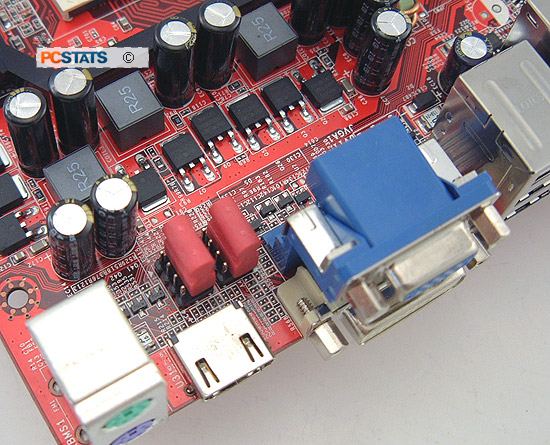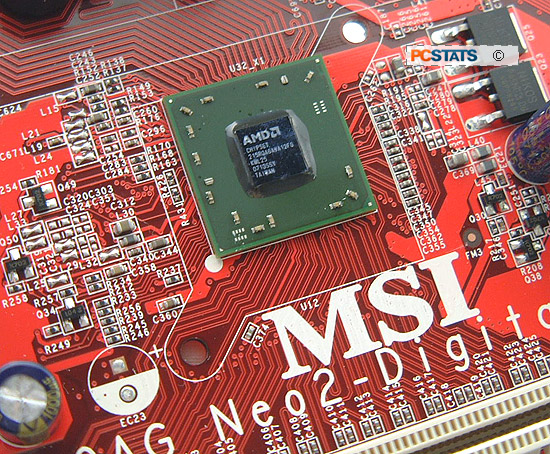|

There is space for
a larger chipset heatsink, though this isn't required because the AMD
690G is fine with small passive aluminum heatsink. As a bonus, it's
totally silent.
|
|

On the rear I/O we
find all the different connectivity ports from displays to
the USB and audio headers. The MSI K9AG Neo2 Digital motherboard supports dual
analog and digital monitors at the same time however the DVI
port does not work with DVI to analog converters. The HDMI jack integrates digital
audio in with the video signal.
|
AMD 690G / ATI RS690 Chipset
The AMD 690G (previously known as the ATI RS690) is designed with Microsoft
Windows Vista in mind, specifically for Vista's AeroGlass feature. It's the
integrated video capabilities that really make this chipset stand out; it
supports all of AMD's 32-bit and 64-bit Socket AM2 processors and features a
Radeon Xpress 1250 DirectX 9.0 compatible graphics core.
AMD's 690G is built on TSMC's 80nm manufacturing process, even though AMD has
its own fabrication plants.
The Radeon X1250 is based on the Radeon
X700 architecture, albeit with four rendering pipelines. That gives AMD a 3D
performance advantage over comparable integrated nVIDIA graphics cards like the
GeForce 6100 series, but not necessarily against the nVidia Geforce 7050. The
integrated videocard supports one TV output DAC for TV output, and HDCP natively
(something the GeForce 6100 series doesn't) through DVI and HDMI.
|

The AMD 690G chipset unmasked
on MSI's K9AG Neo2 Digital motherboard.
|
Within the AMD 690G, the Radeon Xpress 1250 videocard supports dual monitors
(one digital and one analog display). If you want to run dual monitors, one will
have to be analog and the second digital, DVI to analog converters do not work
with the Radeon Xpress 1250, so you cannot connect two analog monitors onto the
onboard videocard.
Should you want to use a stand alone videocard the AMD
690G supports a PCI Express x16 slot. The Radeon Xpress 1250 videocard shares up
to 512MB of installed system memory. The AMD 690G supports up to four PCI Express x1 slots along with six PCI bus
mastering slots, although it's up to the motherboard manufacturer to implement things. There are generally four Serial
ATA II ports and a single Ultra/133 IDE controller, coming from the
AMD SB600 Southbridge.
Also integrated is are ten USB 2.0 ports, a Gigabit MAC and a 7.1 channel
High Definition audio controller. The AMD's 690G chipset is a real challenger to
nVIDIA's old GeForce 6100-series and the new Geforce 7050 chipset, but whether
it truly is faster and a good alternative is something we'll find out in just a
moment.
Overclocking the MSI K9AG Neo2 Digital is next in this PCSTATS
review...
